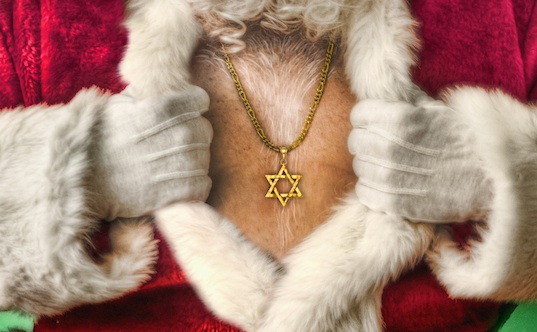(Image from Adam Baron on Flickr Commons)
Back in March, I traveled to a two-day conference called “Rethinking Jewish Identity and Education” at the Mandel Center at Brandeis University. On the flight to Boston, I took a moment to browse the SkyMall catalogue, as I am typically inclined to do. Characterized as “a symbol of America’s love affair with kitsch and a respite for bored airline passengers” by the Los Angeles Times, the catalogue is distributed in the airplane seat pockets on nearly 90 percent of domestic flights in the U.S., reaching more than 650 million air travelers annually.
In this latest issue, I discovered an ad for a battery-operated “deluxe hanukkah tree topper,” described as “the perfect meeting place between two beautiful holiday traditions and bound to generate smiles to all that see it.” About $40 (plus shipping costs) buys you an 8-inch diameter, battery-operated Star of David with a “steel coil for easy mounting atop any size tree.”
I thought about my closest friend from United Synagogue Youth, the Jewish youth group that was the cornerstone of my teen years as I was coming of age in the San Fernando Valley. Dana and her family exposed me to a type of engaged and affiliated Jewish lifestyle that I had not experienced with my own, secular Jewish family. They were part of the spark that ignited my love of being Jewish, which ultimately led to my career as a sociologist of American Jewry.
About eight years ago, Dana married Matt–a kind, thoughtful and charming non-Jewish man who grew up in a holler in Kentucky. He did not convert, but has taken a strong lead as the father of their two children whom they are raising as Jewish. This does not preclude their celebration of Christmas, which features a beautifully trimmed tree. I considered whether the tree topper should be my Chrismukkah gift this year, instead of my usual ornament to add to the tree. I also wondered if any of the other social scientists of American Jewry en route to the conference had come across this cultural artifact, and if so, what was their reaction?
The ad takes a wildly different approach to the fact of inter-marriage than do many of my colleagues. Particularly illustrative of the typical attitude of Jewish scholars and leaders is a recent article commenting on the Pew Research Center’s “Portrait of Jewish Americans,” research based on a national survey of 5,000 individuals who identified as Jews. “Last year’s survey of American Jews brought dire news–rising intermarriage, falling birthrates, dwindling congregations,” the authors–two of the most prominent voices in the field–proclaim.
It is not surprising that they view the ever-rising rates of intermarriage as a cause of the “parlous condition of American Jewry” rather than a phenomenon to be celebrated with some good old-fashioned American consumerism. What the SkyMall catalogue highlights is the disconnect between their assessment of the state of American Jewry and the lived experiences of Jews themselves.
The conference about Jewish identity at Brandeis that I attended amplified another disconnect, this time between scholars of American Jewish identity and social theorists whose articulation of identity informs my work. I understand identity to be “a complex process that produces socially negotiated, temporary outcomes formed between the interplay of self-presentation and labeling by others” (you can find the source of that definition here). In contrast, the majority of scholars at the conference tend to focus on understanding the extent to which subjects enact attitudes and behaviors that have been characterized as Jewish by the researcher. They typically characterize and study Jewish identity as a measurable entity that, once quantified, can potentially be increased, deepened or strengthened.
My work and life regularly bring me into contact with a variety of Jews of different parentage, ages, educational backgrounds, geographic locations and ethnicities. As an applied sociologist, I am hired by Jewish organizations and philanthropists to develop and undertake research and evaluative studies designed to help them understand the impact of their work and to articulate recommendations, based on my findings, to help them accomplish their goals. In this capacity, I often conduct interviews with people about what being Jewish means to them. I feel fortunate to be afforded frequent opportunities to both research and relate to Jews whose understandings of what it means to be Jewish exemplify the nuanced and immeasurable quality of that complex process.
I remain close enough to Dana and her family to have the joy of regularly taking part in their Jewish life and deeply understand their preferred tone and aesthetic. It is for this reason that I decided to skip the gift of the Hannukah tree topper this year–which is just as well, as it has sold out. I suspect that as such trends continue, increasingly stylish products will be developed. Some day soon, when it’s in the Hammacher Schlemmer catalogue, then I’ll know it’s time to buy.
Tobin Belzer is a contributing fellow with the USC Center for Religion and Civic Culture.





